Finding your way around a Chinese supermarket
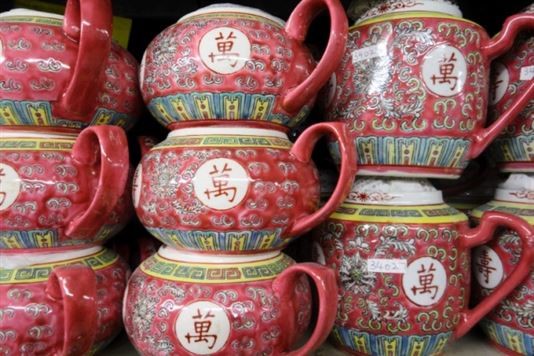
Has curiosity ever led you into a Chinese supermarket but, overwhelmed by how alien everything was, you left empty handed? Let Ilya Fisher be your perfect guide.
Chinese supermarkets are similar to British ones in their arrangement of ingredients. However, because most things have been shipped over from China they look very different to our usual produce – and it can be bewildering. Here is a tour of a typical Chinese supermarket with some useful or particularly interesting items described.
Fresh fruit and veg
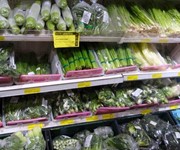 Just like our Western supermarkets, this section starts at the entrance and often spills out onto the street. Here you will find different varieties of Chinese small cabbages (you’re probably familiar with bok choy, but there are many more); bunches of long green or yellow Chinese chives (lovely chopped up with egg and stuffed in Chinese bread buns); different varieties of aubergine; delicate lotus roots (the mysterious, brown sausage-like things); and long white giant Chinese radishes – also known as ‘mooli’ or ‘daikon’ – which are delicious in salads and the basis of fried turnip cake, a fantastic dim sum dish which you can make at home with rice flour.
Just like our Western supermarkets, this section starts at the entrance and often spills out onto the street. Here you will find different varieties of Chinese small cabbages (you’re probably familiar with bok choy, but there are many more); bunches of long green or yellow Chinese chives (lovely chopped up with egg and stuffed in Chinese bread buns); different varieties of aubergine; delicate lotus roots (the mysterious, brown sausage-like things); and long white giant Chinese radishes – also known as ‘mooli’ or ‘daikon’ – which are delicious in salads and the basis of fried turnip cake, a fantastic dim sum dish which you can make at home with rice flour.
You might also find small brown things that look like chestnuts – these are fresh water chestnuts. Just buy one, peel it with a knife, and eat it… wonderful, with a unique crunchy texture and very mild sweet flavor.
Fridge
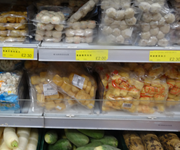 There are fascinating things to be found here. Sealed packets of tofu puffs, for example, which are wonderful added to stir fries or casseroles. Soak them in hot water first to get rid of some of the oil – they have a wonderful spongy texture that absorbs sauces beautifully, and you don’t need to be vegetarian to love them. Try the packets of fish or meat balls too, a really quick ingredient which tastes great added to stir fries, or dropped into a tasty stock with some leafy vegetables, noodles, ginger and chilli. I like the fried prawn ones best. They have an addictive soft but chewy texture.
There are fascinating things to be found here. Sealed packets of tofu puffs, for example, which are wonderful added to stir fries or casseroles. Soak them in hot water first to get rid of some of the oil – they have a wonderful spongy texture that absorbs sauces beautifully, and you don’t need to be vegetarian to love them. Try the packets of fish or meat balls too, a really quick ingredient which tastes great added to stir fries, or dropped into a tasty stock with some leafy vegetables, noodles, ginger and chilli. I like the fried prawn ones best. They have an addictive soft but chewy texture.
Look out for the fresh noodles and dumpling wrappers. These are perfect for a quick meal: make any filling (I used leftover Bolognese once), fill the wrappers, seal the edges with the help of water and steam, and then boil or fry.
Jars and bottles
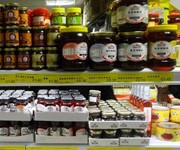 Head here for essential store cupboard ingredients such as soy sauce, both light and dark versions. ‘Light’ is saltier, and ‘dark’ is thicker, sweeter, and richer in colour – for serious Chinese cooking you will need both, otherwise just go for the light version. The Pearl River Bridge brand is good.
Head here for essential store cupboard ingredients such as soy sauce, both light and dark versions. ‘Light’ is saltier, and ‘dark’ is thicker, sweeter, and richer in colour – for serious Chinese cooking you will need both, otherwise just go for the light version. The Pearl River Bridge brand is good.
Nearby you will find toasted sesame oil; choose a pure, unblended one. It’s amazing sprinkled over most Chinese dishes after cooking (don't use it during cooking; high heat will cause the oil to lose its delicate fragrance).
Don’t pass by the chilli sauces. There are several I cannot do without: Pixian brand chilli bean paste for Sichuan dishes (not all oriental supermarkets stock this brand); a jar of pickled chopped chilli; and that lovely, deep red chilli oil with flakes. Way-On does a great vegetarian version, which doesn’t contain MSG but tastes just as good as those that do. It’s invaluable both as a condiment and for cooking.
Black Chinkiang vinegar is also here, used in cooking for its rich complex flavour (think Balsamic) and the wonderful zingy lightness it gives to dishes.
Dried goods
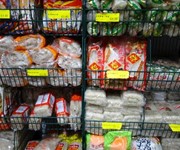 Rice, noodles, tea, spices… lots of useful items here. Pick up a pack of star anise – they smell fantastic and are good value. Notice some multipacks of individual portion-sized clear noodles? They are probably mung bean starch noodles, really useful to have at home because of their single portion size and speed of preparation. You simply soak them for a few minutes in just-boiled water until they are soft, and then use in soups, stir fries, or top with a sauce. Very similar to rice noodles.
Rice, noodles, tea, spices… lots of useful items here. Pick up a pack of star anise – they smell fantastic and are good value. Notice some multipacks of individual portion-sized clear noodles? They are probably mung bean starch noodles, really useful to have at home because of their single portion size and speed of preparation. You simply soak them for a few minutes in just-boiled water until they are soft, and then use in soups, stir fries, or top with a sauce. Very similar to rice noodles.
Black mushrooms and other dried exotic ingredients are also found here, such as wood ear mushrooms (they look a bit like black dried-up leaves), which make a great healthy salad with coriander, garlic, chilli, vinegar and sesame oil.
Look out for packets of fermented black beans and preservative-free pickled vegetables, which I use in a lot of Sichuan dishes for their savoury, salty, crunchy properties. You might also find packs of huge green fan-shaped leaves – these are lotus leaves which you soak, stuff with glutinous rice, and steam.
Frozen
 Here you will find dozens of premade dim sum which you only need to heat up. Although the packets will often be in Chinese, there’s usually an ingredient list and instructions in English too. This goes for almost everything in the frozen section, often added on as a large sticker label.
Here you will find dozens of premade dim sum which you only need to heat up. Although the packets will often be in Chinese, there’s usually an ingredient list and instructions in English too. This goes for almost everything in the frozen section, often added on as a large sticker label.
You might see packs of glutinous rice balls which make a wonderful dessert or snack; just take a few out of the freezer, drop into a pan of boiling water, and they are ready when they rise to the surface (a few minutes). The ones filled with black sesame are delicious.
Hardware
 This section will feature woks of all sizes, bamboo wok brushes for scrubbing your wok clean, and colourful, fat straws for slurping up the tapioca balls of homemade bubble tea (my teenage daughter sometimes makes bubble tea when she gets in from school). For reference, black or multicoloured tapioca balls can be found in clear vacuum packs in the dry goods section; just boil in a small saucepan of water for a few minutes until soft, and drop into a cup of strong, iced sweet milky tea.
This section will feature woks of all sizes, bamboo wok brushes for scrubbing your wok clean, and colourful, fat straws for slurping up the tapioca balls of homemade bubble tea (my teenage daughter sometimes makes bubble tea when she gets in from school). For reference, black or multicoloured tapioca balls can be found in clear vacuum packs in the dry goods section; just boil in a small saucepan of water for a few minutes until soft, and drop into a cup of strong, iced sweet milky tea.
There might also be a range of dishes, bowls, teapots and cups, ceramic soup spoons and those really useful tiny dishes for putting dipping sauce in.
Here too you will find the cleavers: the lighter ones are perfect for chopping and cutting (use the flat blade for scooping up chopped ingredients and transferring to your wok); and the really heavy ones are for chopping bones. Have a good exploration of this area – you might even spot some ancient, rustic-looking clay pots, ideal for slow gentle braising and beautiful for serving dishes.
Alcohol and high value items
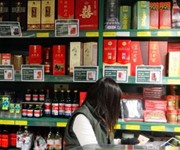 Shaoxing cooking wine is usually kept on the shelves behind the tills, along with other alcoholic and expensive items. A spoonful or two of Shaoxing wine is found in many recipes, so it’s useful to keep a bottle at home. There are other fascinating things on these shelves such as bottles of a spirit called bai jiu in brightly coloured packaging; strong white spirits at a few hundred pounds each or more; and pricey exotic ingredients such as a box of dried scallops or a tin of abalone.
Shaoxing cooking wine is usually kept on the shelves behind the tills, along with other alcoholic and expensive items. A spoonful or two of Shaoxing wine is found in many recipes, so it’s useful to keep a bottle at home. There are other fascinating things on these shelves such as bottles of a spirit called bai jiu in brightly coloured packaging; strong white spirits at a few hundred pounds each or more; and pricey exotic ingredients such as a box of dried scallops or a tin of abalone.
So that’s it! A quick tour of your local Chinese supermarket. Maybe next time you visit you’ll leave with several heavy shopping bags, and plans for adventures in the kitchen…
You might also like
Sichuanese 'dry-fried' green beans
Comments
Be the first to comment
Do you want to comment on this article? You need to be signed in for this feature